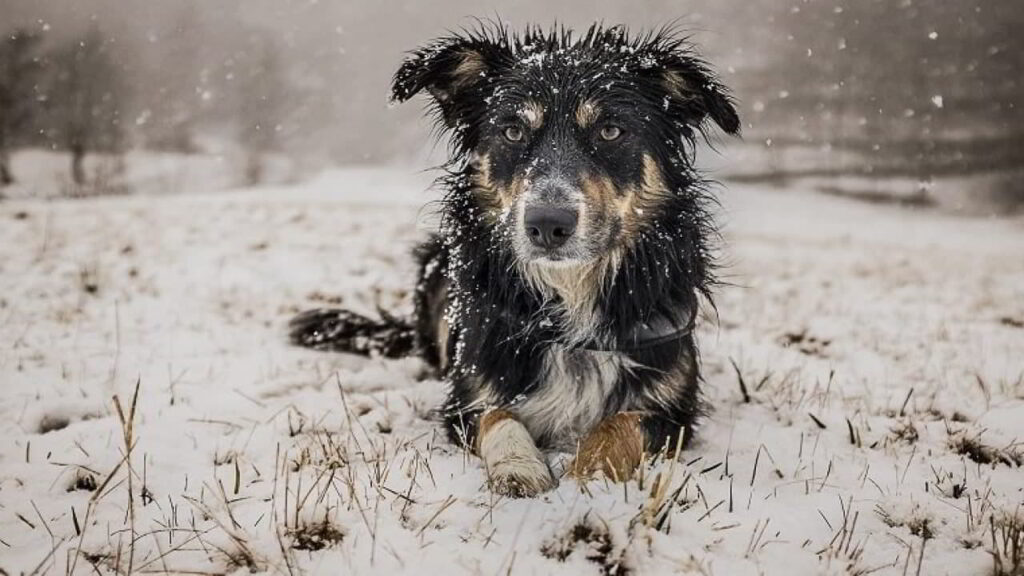A fur coat doesn’t make puppies immune to hypothermia, a condition when the pet’s body temperature falls below normal. Puppies normally conserve body heat by seeking shelter, curling up, and fluffing their fur to trap warm air next to the skin. A short-haired puppy, though, doesn’t have much protection; however, shivering generates heat. In cold weather, a puppy’s body diverts blood circulation from the ear tips, toes, and tail to the central part of the body. Prevention is the best policy, and the best prevention is to keep pets indoors during inclement weather.
Normal Body Temperature
In adult dogs, normal temperature ranges from about 100 degrees F to 102.5 degrees F. Very young puppies-those under about 6 weeks of age-have trouble maintaining body temperature. That’s why they hunker down next to mom and sleep in puppy piles with their siblings. Huddling together cuts down on wind loss of heat, and the multiple furry bodies can share and boost each others’ warmth, avoiding a cold puppy.
Outdoor Dangers
Pets who live outside during the coldest months are at the highest risk of hypothermia, but even moderately cool temperatures can be dangerous. A 20 mph wind makes 40-degree weather feel like 18 degrees. Sometimes CPR or rescue breathing is necessary, but you should avoid moving the puppy to prevent additional heat loss. That can make even moderate temperatures dangerous. If it rains or snows and soaks your puppy, wet fur chills the pet even more.
Mild to Moderate Hypothermia
Mild hypothermia occurs when body temperature falls between 90 degrees to F to 99 degrees F and causes pets to act a bit sluggish and lethargic. You’ll see muscle tremors and shivering.

Bring the puppy inside, dry him off, and turn up the heat and he should recover with no problem. If you can’t get the pet someplace warm, try putting him inside your clothing to share your body heat.
Moderate hypothermia is defined as a temperature between 82 degrees F to 90 degrees F. These pets can also be treated at home but may take longer to recover. Wrap him in a towel or blanket that’s been heated in the clothes dryer, or wrap a heating pad in a blanket or towel and apply it to the dog.
Severe Hypothermia
Severe hypothermia, which is a body temperature less than 82 degrees F, can be deadly. Pets lose the ability to shiver if their body temperature falls to 90 degrees F or below, so a still puppy is a warning sign of hypothermia. The dog might fall unconscious while breathing and heart rate slows to the point the puppy may appear dead. The wind strips away that layer of warm air trapped by fur next to their skin.
Any pet suffering from severe hypothermia-that is, body blue and cold, and unable to shiver-needs immediate veterinary care. When body temperature has been below 90 degrees F for more than 30 minutes, “core rewarming” is necessary, which refers to warming the pet from the inside using specialized veterinary techniques.
Dry the puppy off, and wrap him in warm blankets. During the car ride to the emergency room, it may be helpful to apply a hot water bottle that’s end up being wrapped in a towel to his groin area because the femoral artery lies close to the surface of the skin. The hot water bottle applied to this area can help warm the blood so it circulates and speeds up his re-hosting.
Pets in severe hypothermia risk shock. Rub a bit of Karo syrup or honey on the puppy’s gums. The sugar is absorbed through the twill be sue, and that may help raise his blood glucose levels and counter the risk of shock.

Veterinary Treatment
Your veterinarian may treat severely hypothermic pets with warm intravenous fluids, warm water enemas, airway rewarming using oxygen or even heart/lung bypass machines that warm the blood. Even with treatment, the prognosis is guarded in cases of severe hypothermia because organs and tissues are often irreparably damaged.
Dogs that have suffered hypothermia in the past are in greater risk in the future for a relapse. Damage caused by the extreme cold reduces the body’s ability to stay warm.
By Dog Care Tip


0 Comments